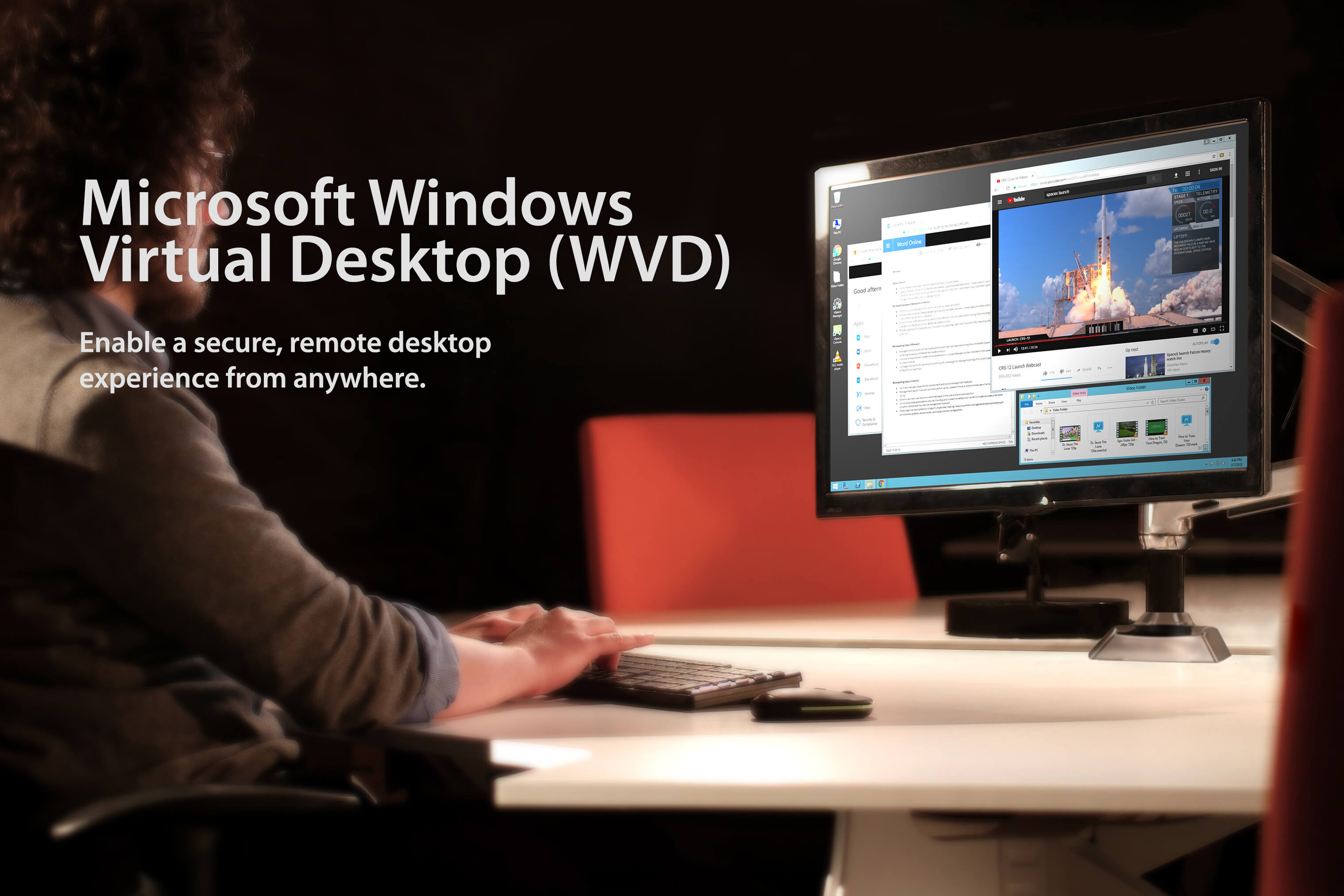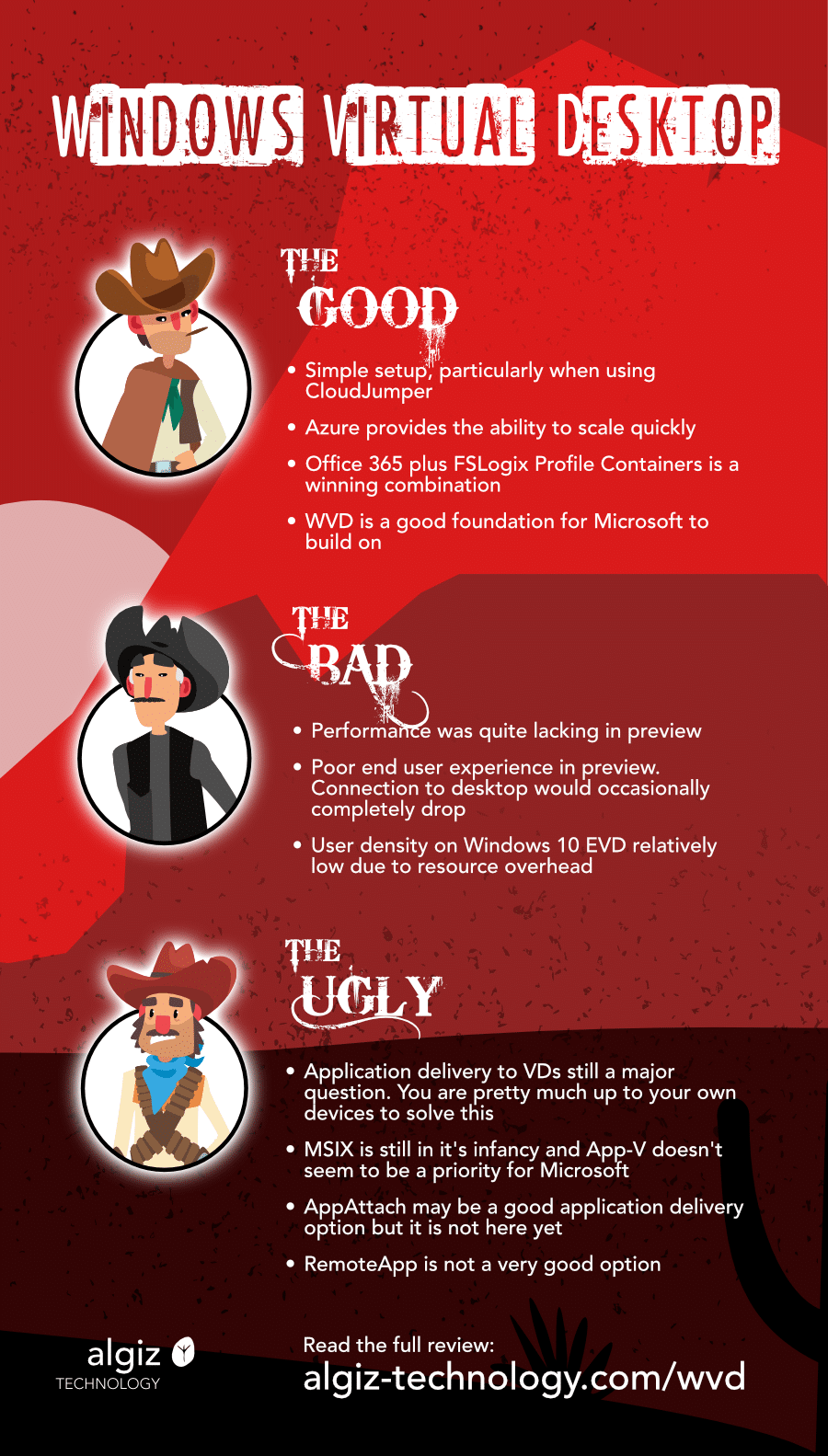Windows virtual desktop (WVD) offers access to various apps hosted by a local server remotely. Currently, small and medium enterprise firms are embracing the use of Citrix, VMware view as options for remote desktop applications. Windows virtual desktop (WVD) succeeded in remote desktop services (RDS) and virtual desktop infrastructure (VDI). You can use the Remote Desktop client for Windows Desktop to access Windows apps and desktops remotely from a different Windows device. Windows Virtual Desktop is the only service that delivers simplified management, a multi-session Windows 10 experience, optimizations for Office 365 ProPlus, and support for Windows Server Remote Desktop Services (RDS) desktops and apps. With Windows Virtual Desktop, you can deploy and scale your Windows desktops and apps on Azure in minutes.
Windows Virtual Desktop (WVD). What services does it offer?
Windows Virtual Desktop hosts can provide both full Session Desktops and RemoteApps, but not at the same time from the same host pool. Although a single Host Pool can provide both RemoteApps and Session Desktops, users can only be assigned to one or the other. If a user requires both, multiple Host Pools would be needed. This was something that could be achieved in RDS by using an unsupported reg hack.

How do I publish Desktops and RemoteApps?
Once a Host Pool has been successfully deployed the Session Desktop offering is deployed as the default. If you do not plan to offer this service, the AppGroup for it can be deleted.
To publish RemoteApps, first you need to create an AppGroup that is configured specifically for RemoteApps. You can use the New-RDSAppGroup cmdlet with the -ResourceType parameter to do this. Apps can then be published using the New-RDSRemoteApp cmdlet. This requires several parameters being passed though. To simplify things, I personally use a command that takes advantage of a predefined set of variables:
$myTenantName = “<Tenant Name>”
$HostPool = “<Host Pool Name>”
$AppGroup = “<AppGroup Name>”
$AppName = “<Application Name>”
$AppFreindlyName = “<App Friendly Name>”
$FilePath = “<Path to executable>”
$IconPath = “<Icon file location>”
$IconIndex = “0”
New-RdsRemoteApp -TenantName $myTenantName -HostPoolName $HostPool -AppGroupName $AppGroup -Name $AppName -FilePath $FilePath -FriendlyName $AppFreindlyName -IconPath $IconPath -IconIndex $IconIndex
Additional parameters can be added for command line requirements if needed.
How are resources assigned?
Users are assigned resources using AppGroups. You can either use PowerShell (Add-RdsAppGroupUser -TenantName <tenantname> -HostPoolName <hostpoolname> -AppGroupName <appgroupname> -UserPrincipalName <userupn>) or the management portal to assign users. This must be done on a per user basis as assignment through group membership is not currently available. My guess is that this is to make sure that users don’t accidentally end up in conflicting AppGroups. Users can be a member of multiple AppGroups from a single Host Pool providing that they provide the same service.
How are resources accessed?
Apps or desktops are access though the universal WVD login address. The portal takes advantage of any existing SSO configuration and can be added to existing Conditional Access rules if needed.
The feed can also be added to the preview version of the Remote Desktop Client app or be pushed into a computer’s local configuration for RemoteApp and Desktop Connections with Group Policy. This gives seamless integration into the users Start Menu, presenting the app like any other locally installed one.
Windows Virtual Desktop. Want to know more?
Stay tuned for Part 6 of this WVD based blog series where I’ll be discussing how to manage the WVD service.
Here at Silversands we have already begun meeting with customers, designing and implementing proof of concepts for WVD with universal praise for the service.
We host regular events so please do check our schedule of current seminars, webinars and events. We also post regular blogs on the latest updates and expert advice on Microsoft 365, Cloud and Hybrid IT, User Adoption and the Power Platform, so please do follow us.
Please do use the form below to get in touch with any questions or queries.
Last Updated on August 12, 2020 by
In my previous blog post, I have explained how we can set up Windows Virtual Desktop (Spring 2020 Release) and publish desktops. If you didn’t read it yet, please go ahead and read it before we continue with this article as I am going to use the same system setup. You can access previous blog post using this link.
In this blog post, I am going to demonstrate how to publish applications using Windows Virtual Desktop (Spring 2020 Release).
Before we start, let’s go ahead and check how is my demo environment looks like and what I am trying to achieve.
• I have two Resource groups in place. EUSRG1 resource group is in Azure East US region and UKSRG1 resource group is in UK South Azure region.
• Resource in UKSRG1 resource group represents my on-premises infrastructure.
• I have a Windows AD server running in UKSRG1. It is syncing to Azure AD by using Azure AD Connect.
• EUSVNet1 and UKSVnet1 are connected using Azure VNet-to-VNet VPN Gateway Connection (https://www.rebeladmin.com/2019/09/step-step-guide-setup-azure-vnet-vnet-vpn-gateway-connection-powershell-guide/). This way session hosts in EUSRG1 can be added to Windows AD using the standard method.
• I have set up two windows virtual desktop session hosts (REBELSH-0 & REBELSH-1) and a workspace (REBELWP01) in EUSRG1 resource group.
Both session hosts are joined to Windows AD using the standard domain join method.

I am going to create a new application group and publish Microsoft Word and Microsoft Excel Applications.
Create Windows Virtual Desktop Application Group
Let’s go ahead and create the application group for remote apps.
1. Log in to Azure portal as Global Administrator
2. Search for Windows Virtual Desktop and click on it.
3. Then click on Application groups
4. In Application group page click on + Add
5. This will open up a new wizard. In there, first, select the resource group. According to my setup, it should be EUSRG1. Then select the Host pool. I already have a host pool setup with the required applications. The application group type should set to RemoteApp. Under the Application group name, define a name for the app group. After all settings are in place click on Next : Assignments to proceed.
6. In assignments page, click on + Add Azure AD users or user groups to assign users to the application group. With Spring 2020 Release, now you can assign permissions to Azure AD groups. In my demo setup, I have Azure AD group called “REBELADMIN App Group“. I am going to assign this new app group to it. After settings are applied, click on Next: Application
7. In the Application page, click on + Add applications.
8. It will open up a new wizard. In their select Start menu as the Application source. This will retrieve the applications available in the session host’s start menu. For custom apps, we can select File path as the application source and define the exe path. Next, using Applications option, select the application you like to publish. In my demo, I am going to publish Microsoft Word. If you need, you can change the application name by modifying value in Display name field. In the end, click on Save to publish the application.
Windows Virtual Desktop Remote Application
Same way, I added Microsoft Excel application to the list. In the end, click on Next: Workspace to proceed.
9. In Workspace page, Click on Yes for Register application group option. This is to register the application group with the workspace. I already have a workspace setup. So, this new group will also register with the existing workspace. After settings are in place, click on Review + Create to complete the application group configuration process.
10. In the next window, the system will validate the settings. Once validation is completed, click on Create.
This completes the configuration process; let’s go ahead and test the remote app access.
Testing


There are many different ways to connect to Windows virtual desktop services. In this demo, I am using web client method.

1. Launch web browser and go to https://rdweb.wvd.microsoft.com/arm/webclient
2. Then I am login as a member of “REBELADMIN App Group”
Getting Started With Windows Virtual Desktop
3. Once I logged in, I can see the applications I just published.
4. I went ahead and click on Microsoft Word.
5. Then system prompt for permissions to access local resources. Click on Allow to proceed.
Windows Virtual Desktop Remote App
6. In the next window, the system asks for credentials again. I type the same login details and click on Submit.
7. Then as expected, I can see the Microsoft Word App.
Windows Virtual Desktop Tutorial
This marks the end of this blog post. Hope now you have a better understanding of how to publish applications using Windows Virtual Desktop. If you have any further questions feel free to contact me on rebeladm@live.com also follow me on twitter @rebeladm to get updates about new blog posts.
